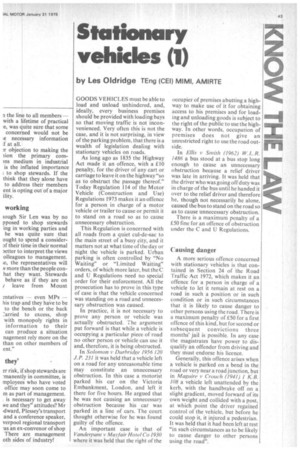Stationary vehicles (1)
Page 47

If you've noticed an error in this article please click here to report it so we can fix it.
by Les Oldridge TEng (CEI) MIMI, AMIRTE GOODS VEHICLES must be able to load and unload unhindered, and, ideally, every business premises should be provided with loading bays so that moving traffic is not inconvenienced. Very often this is not the case, and it is not surprising, in view of the parking problem, that there is a wealth of legislation dealing with stationary vehicles on roads.
As long ago as 1835 the Highway Act made it an offence, with a £10 penalty, for the driver of any cart or carriage to leave it on the highway "so as to obstruct the passage thereof." Today Regulation 114 of the Motor Vehicle (Construction and Use) Regulations 1973 makes it an offence for a person in charge of a motor vehicle or trailer to cause or permit it to stand on a road so as to cause unnecessary obstruction.
This Regulation is concerned with all roads from a quiet cul-de-sac to the main street of a busy city, and it matters not at what time of the day or night the vehicle is parked. Urban parking is often controlled by "No Waiting" or "Limited Waiting" orders, of which more later, but the C and U Regulations need no special order for their enforcement. All the prosecution has to prove in this type of case is that the vehicle concerned was standing on a road and unnecessary obstruction was caused.
In practice, it is not necessary to prove any person or vehicle was actually obstructed. The argument put forward is that while a vehicle is occupying a particular piece of road no other person or vehicle can use it and, therefore, it is being obstructed.
In Solomon v Durhridge 1956 120 J. P. 231 it was held that a vehicle left on a road for any unreasonable time may constitute an unnecessary obstruction. In this case a motorist parked his car on the Victoria Embankment, London, and left it there for five hours. He argued that he was not causing an unnecessary obstruction because his car was parked in a line of cars. The court. thought otherwise for he was found guilty of the offence.
An important case is that of Vanderpant v Mayfair Hotel Co 1930 where it was held that the right of the occupier of premises abutting a highway to make use of it for obtaining access to his premises and for loading and unloading goods is subject to the right of the public to use the high way. In other words, occupation of premises does not give an unrestricted right to use the road outside.
In Ellis v Smith (1961) W.L.R. 1486 a bus stood at a bus stop long enough to cause an unnecessary obstruction because a relief driver was late in arriving. It was held that the driver who was going off duty was in charge of the bus until he handed it over to the relief driver and therefore he, though not necessarily he alone, caused the bus to stand on the road so as to cause unnecessary obstruction.
There is a maximum penalty of a £50 fine for an offence of obstruction under the C and U Regulations.
Causing danger
A more serious offence concerned with stationary vehicles is that contained in Section 24 of the Road Traffic Act 1972, which makes it an offence for a person in charge of a vehicle to let it remain at rest on a road in such a position or in such condition or in such circumstances that it is likely to cause danger to other persons using the road. There is a maximum penalty of £50 for a first offence of this kind, but for second or subsequent convictions three months' jail is possible. In any case the magistrates have power to disqualify an offender from driving and they must endorse his licence.
Generally, this offence arises when a vehicle is parked on a bend in the road or very near a road junction, but in Maguire v Crouch (1941) I K. B. 108 a vehicle left unattended by the kerb, with the handbrake off on a slight gradient, moved forward of its own weight and collided with a post, at which point the driver regained control of the vehicle, but before he could stop it, it injured a pedestrian. It was held that it had been left at rest "in such circumstances as to be likely to cause danger to other persons using the road".






























































































